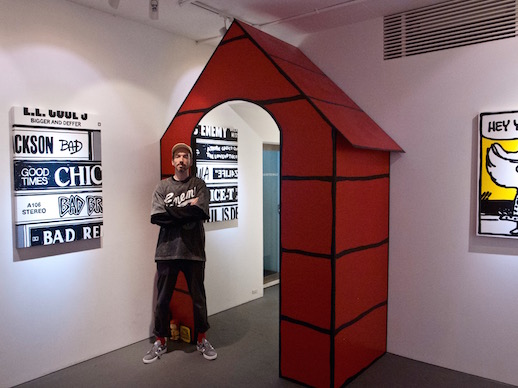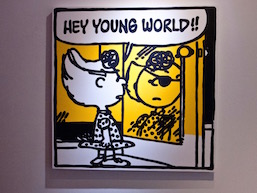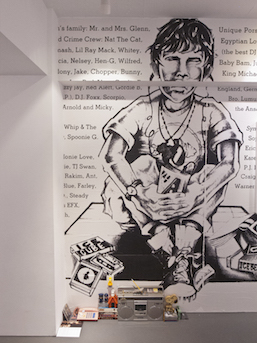“..Ain’t No Fun!!”

“..Ain’t No Fun!!” is the latest exhibition by artist Mark Drew. It shares its title with a track from Snoop Doggy Dog’s 1993 debut album “Doggystyle,” perfectly representing art in its visual sampling of Peanuts comics mixed with late-80s to early-90s hip-hop lyrics. Working from this motif, the show is made up of paintings and installations revealing both surface and deeper elements of Drew’s take on the art of the pop culture reference.

Upon entering the gallery, there is a wooden installation of Snoopy’s doghouse. Peculiar, you will notice the entrance of the doghouse is facing the gallery instead of the entrance, which would have been metaphoric of us coming into the artist’s world from the outside. Fans of the comics will recall Snoopy always slept on top of the doghouse – His world too was on the outside, with daydreams of flying as a WWI pilot and other fantasies that teased our perceptions of reality. The painting immediately adjacent to the entrance is of Sally Brown looking into the mirror with the caption, “Hey Young World!!” This is a Slick Rick song with the idea of youth reflected in Charlie Brown’s younger sister. To cap it off, the acrylic painting of Sally features an eye patch, a signature of Slick Rick. Bouncing around there is another painting of Schroeder dragging a baseball bat with the Rakim lyric “Thinkin’ how could I get some dead presidents?” This painting is the only one with an orange tone, a satirical wink at Donald Trump. These two paintings alone amply demonstrate the artist’s attention to detail that often results in double (sometimes triple) metaphors, which is entirely characteristic of the hip-hop of the time. If you really know the material or are sensitive enough to perceive the nuances, you are extra rewarded. Although most will miss these details, there is still fun in the exhibit on a surface level…a lot like that of say, an early-90s G-Funk record.
It is precisely these layers of meaning that separate Drew’s work from the seemingly endless parade of hip-hop re-imagined with pop culture references that make up so much of the popular/street art today. Sometimes visiting these shows, one could imagine bringing a bingo card with a hip-hop square in the middle as the free space surrounded by everything from Marvel and Star Wars to The Simpsons and anime. The problem then becomes, aside from the lazy cultural appropriation or rather misappropriation, that the reference never goes beyond a surface layer and comes off tailored for a culture of materialistic hype. The art becomes a slave to the “culture” instead of commenting on it. In Drew’s art, hip-hop is the alibi: For instance, in a previous exhibition that started with a Gravediggaz lyric and ended in a thorough exploration of the Chinese bootleg culture, the sampled hip hop lyrics relate when you realize the front man of the group was Wu tang member RZA, who takes from Chinese culture. Drew’s work is also a broader commentary on art as a commodity, yet on the surface it appears to be just Peanuts and 90s hip hop lyrics.

Returning to the idea of misappropriation, hip-hop becomes even more fragile when it’s tossed into these re-imagined art mixes. The white majority has been adopting and stereotyping black culture since as early as the 20s with jazz, and it was quite a shock in America when hip-hop was on the rise and buying behaviors showed its major demographic was actually whites, prompting conservatives to push for censorship and companies to start tailoring the music to its new audience. The result was quite evident in the music suffering, while everyone outside of the community profited. This lazy hip-hop gimmick art then just becomes a continuation of this misappropriation by another means.
Not shying away from commenting on the phenomenon, Drew utilizes Ice T’s album cover for “Home Invasion” as a backdrop to the exhibition. The album cover (for those not familiar) is of a white teenager sitting in his room listening to hip-hop music expressing all the ills and dangers that stereotype African Americans. So here literally in the background, the artist is entirely aware of the trappings, going so far as to comment upon it. The inside of the cassette cover reveals Ice T’s intention for the album, finishing with “The injection of black rage into the American white youth is the last stage of preparation for the revolution. Prepare – it’s goin’ down.” This isn’t harped on as the artist’s own manifesto or justification even. It is just simply there for anyone to go deeper. This level of nuance simply doesn’t exist in hip-hop elements attributed to say, Ukiyo-e paintings or Star Wars characters in wave caps.
So this is the underlying point in Mark Drew’s art: There are details and layers of meaning in cultural reference points that are extremely accessible to a public who may or may not go deeper. The depth is there to be discovered in Drew’s work, though, from the broken Snoopy clock stuck on 4:20, to the gangster rap cassette tapes juxtaposed with a stuffed toy version of the Japanese police mascot Pipo-kun. (Beyond the hip-hop commentary, this second display references another one of the artist’s exhibits while remaining personal since he is Japan based). It is all quite sincere. There are also paintings of other types of music from roughly the same time period, rewinding back to Drew’s childhood as a kid who sat alone in his room listening to music while daring to think deeper.



